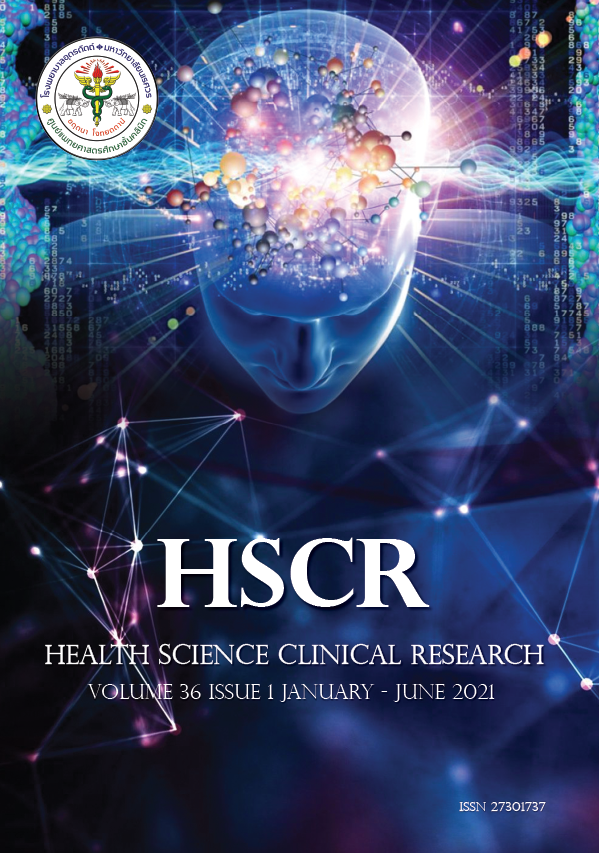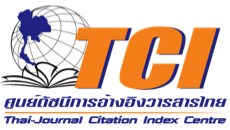Risk Factors of Febrile Neutropenia in Patients with Lymphoma Receiving Chemotherapy
Keywords:
Lymphoma Fever, Neutropenia, ChemotherapyAbstract
ABSTRACT
Background: Febrile neutropenia is a serious complication after receiving chemotherapy and cause
of dead is important
Objective: To study incidence and risk factors of febrile neutropenia in lymphoma receiving
chemotherapy
Methods: This is an analytical retrospective study. The lymphoma patients who had been treated with
chemotherapy in phetchabun hospital and had been enrolled from 1 October 2016 - 30 September 2019.
The data from medical records were reviewed of personal demographic and disease characteristics.
Statistical analyzed using descriptive statistic, chi-square test, Fisher exact test and binary logistic
regression
Results: There were 135 patients diagnosed with lymphoma receiving chemotherapy. The incidence
of febrile neutropenia was 32.6% (44 of 135). Known source of infections in 29 patients (65.9%).
The most common sites of infections was lungs (27.7%). The mortality rate was 15.9%. In univariate
analysis the significant risk factors associated for febrile neutropenia were albumin, hemoglobin and
LDH . In multivariable analysis shown that the risk factors of febrile neutropenia were albumin <3.5 g/dl
(Adj. OR= 9.17; 95%Cl= 2.78-30.24, p<.001) and hemoglobin < 12g/dl (Adj. OR= 6.28; 95%Cl=1.51-
26.09, p=.012) respectively.
Conclusion: The serum albumin and hemoglobin levels were found that to be statistically significant
predictors of febrile neutropenia. Therefore, Risk factor assessment and appropriated prevention
should be provided.
Keywords: Lymphoma Fever Neutropenia Chemotherapy
References
จาก http://www.nci.go.th
2. ถนอมศรี ศรีชัยกุล, ลัดดา สรคุณพิพิธกุล. วิวัฒนาการของมะเร็งระบบนํ้าเหลืองชนิด non-Hodgkin lymphoma
[อินเตอร์เน็ต].2553 [เข้าถึงเมื่อ 3 ก.พ.2563].เข้าถึงได้จาก http://www.thailymphoma.org.
3. Coleman M, Castillo JJ, Cheson DB, Dunleavy K, Freedman SA, Friedbery WJ, et al. Understanding non-
Hodgkinlymphoma.Lymphoma Research Foundation [Internet].2017 [ cite 2020 feb 3]; Available from:
http://www.lymphoma.org.
4. จิตติมา ปูชิตเสถียร, พลภัทร โรจน์นครินทร์. ภาวะไข้ร่วมกับเม็ดเลือดนิวโทรฟิลตํ่าพบบ่อยในผู้ป่วยมะเร็งต่อมนํ้าเหลืองชนิด
นอนฮอดจ์กินที่ได้รับยาเคมีบำบัด CHOP แม้จะรับ G-CSF แบบป้องกัน. วารสารโลหิตวิทยาและเวชศาสตร์บริการโลหิต 2560;
27(1): 45-55
5. ฐิรภัทร จิตต์โสภักตร์. ภาวะไข้ร่วมกับเม็ดเลือดขาวตํ่าในผู้ป่วยมะเร็งโลหิตวิทยาในโรงพยาบาลสวรรค์ประชารักษ์. สวรรค์
ประชารักษ์เวชสาร2556; 10(2): 41-55
6. ณรงค์ ชัยวุฒินันท์, อุมาพร อุดมทรัพยากุล. ผลการรักษาผู้ป่วย non-Hodgkin lymphoma ในโรงพยาบาลมหาราช
นครศรีธรรมราช.วารสารการแพทย์ 2562; 33(3): 403-416
7. Morrison AV, Weller AE, Habermann MT, Li S, Fisher IR, Cheson DB, et al. Patterns of growth factor usage
and febrile neutropenia among older patient with diffuse large B-cell non-Hodgkin lymphoma treared with
CHOP or R-CHOP: The intergroup experience. Leuk Lymphoma 2017; 58(8), 1814-1822
8. Usami E, Kimura M, IWAI M, Takenaka S, Terramachi H, Yoshimura. Chemotherapy continuity and incidence
of febrile neutropenia with CHOP therapy in and outpatient setting. Molecular and Clinical Oncology 2016; 4,
591-596
9. ธงชัย ลีลายุทธชัย, นงลักษณ์ คณิตทรัพย์. ภาวะไข้จากเม็ดเลือดขาวตํ่าของผู้ป่วยหลังการรักษาด้วยยาเคมีบำบัดในแผนก
อายุรกรรม โรงพยาบาลธรรมศาสตร์เฉลิมพระเกียรติ. วารสารโลหิตวิทยาและเวชศาสตร์บริการโลหิต 2553;20(3): 197-203
10. ปิยะวดี เทพรัตน์, นงลักษณ์ คณิตทรัพย์. ปัจจัยที่มีผลต่อการเกิดภาวะไข้จากเม็ดเลือดขาวตํ่าของผู้ป่วยมะเร็งหลังการรักษา
ด้วยยาเคมีบำ� บัด.ธรรมศาสตร์เวชสาร 2558;15(2): 200-208
11. Dendle C, Glibertson M, Spelman T, Stuart LR, Korman MT, Thursky K, et al. Infection is an independent
predictor of death in diffuse large B-cell lymphoma. Scientific Reports 2017; 7, 1-10
12. วันเพ็ญ เอี๊ยะเผ่าพันธ์, ธีระ ฤชุตระกูล, กิติพงษ์ หาญเจริญ, สุคนธาศิริ. การเกิดไข้ในภาวะเม็ดเลือดขาวตํ่าเร็วในกลุ่มผู้ป่วย
มะเร็งเม็ดเลือดขาวเฉียบพลันชนิดไมอีลอยด์ที่ได้รับยาเคมีบำบัดเพื่อชักนำให้โรคสงบสมบูรณ์ที่โรงพยาบาลศิริราช. Graduate
Research Conference Khon Koen University 2557: 1675-1685
13. Yokoyama M, Kusano Y, Nishihara A, Inoue N, Nishimura N, Mishima Y, et al. Incidence and risk factors of
febrile neutropenia in Japanese patients with non- Hodgkin B-cell lymphoma receiving R-CHOP: 2 year
experience in a single center. Support Care Cancer 2020; 28, 571-579
14. Yokoyama M, Kusano Y, Takahashi A, Inoue N, Ueda K, Nishimura N, et al. Incidence and risk factors of febrile
neutropenia in patients with non-Hodgkin B-cell lymphoma receiving R-CHOP in a single center in Japan.
Support Care Cancer 2017; 25, 3313-3320
15. Choi WY, Jeong HS, Ahn SM, Lee WH, Kang YS, Choi HJ, et al. Patients of neutropenia and risk factors for
febrile neutropenia of diffuse large B-cell lymphoma patients treated with rituximab-CHOP. J Korean Med
Sci 2014; 29(11), 1493-1500
16. ไนยรัฐ ประสงค์สุข. Common side effect of chemotherapy [อินเตอร์เน็ต]. 2559 [เข้าถึงเมื่อ 3 ก.พ.2563]. เข้าถึงได้
จาก http://www.thethaicancer.com
Downloads
Published
How to Cite
Issue
Section
License

This work is licensed under a Creative Commons Attribution-NonCommercial-NoDerivatives 4.0 International License.
The names and email addresses entered in this journal site will be used exclusively for the stated purposes of this journal and will not be made available for any other purpose or to any other party.











